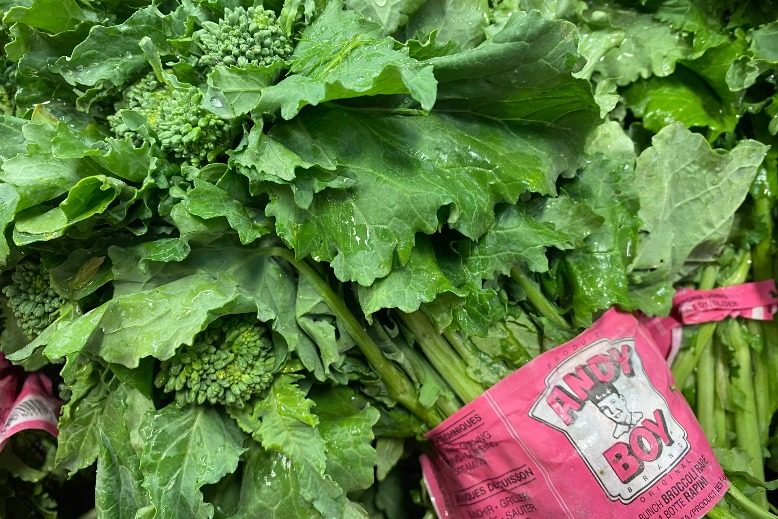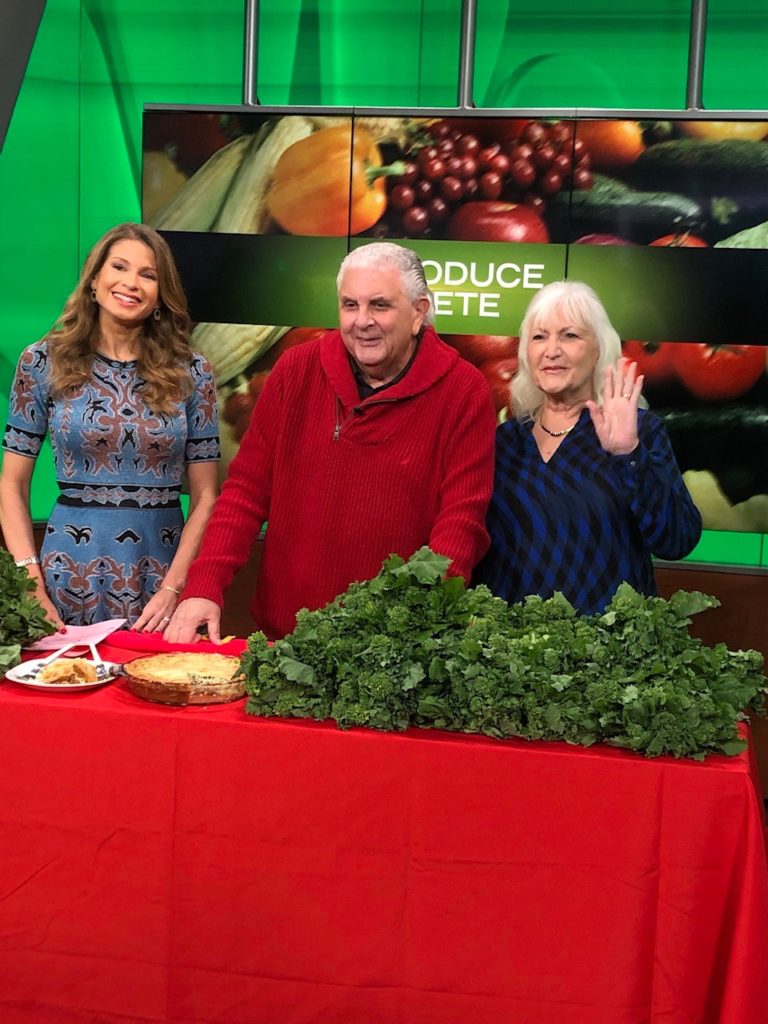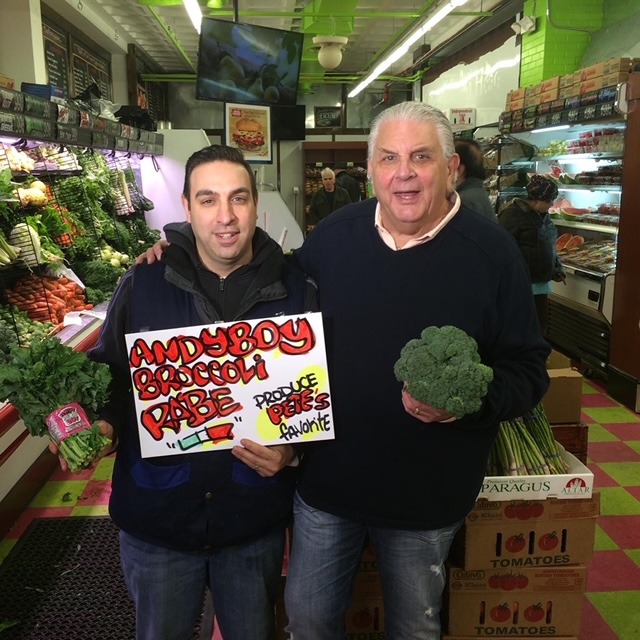
Whenever I think of broccoli rabe, my father always comes to mind. As one of 20 children growing up in Italy, Pop would always complain that all he ever had to eat as a kid was broccoli rabe, because in his day it was a cheap vegetable his mother could stretch to feed the whole family and keep them filled up. They had broccoli rabe with eggs, broccoli rabe sandwiches, broccoli rabe with pasta, broccoli rabe with potatoes…rabe, rabe, rabe! They had so much broccoli rabe that my father once swore he’d never eat it again. But he still loved it, and so do I.
Today, broccoli rabe is no longer cheap. In fact, it’s quite the gourmet dish in many restaurants. When I was growing up, I remember my mother cooking broccoli rabe on the stove in the back of Napolitano’s Produce, our store in Bergenfield, and I would always break off a piece of bread and dip it into the frying pan to get a taste. The aroma of mom’s cooking would fill the store and customers would always make their way to the back to ask mom what she was cooking, and invariably buy the same ingredients so that they could make it for themselves at home. I miss those days working alongside my parents and brother in our family business. But while times may have changed, one thing never has—broccoli rabe is still our family’s favorite vegetable.
The Back Story on Broccoli Rabe

Produce Pete touts the benefits of broccoli rabe with anchorwoman Jen Maxfield (left) and his wife Bette during a recent segment on NBC Weekend Today in New York. Photo courtesy of Pete Napolitano/NBC
Broccoli rabe is a non-heading variety of broccoli that’s also known as broccoletti di rape, brocoletto, rapini, choy sum, or Chinese flowering cabbage. It has long, thin, leafy stalks topped with small heads that look like tiny broccoli florets and, while the leaves are slightly bitter, the florets are quite delicate. Broccoli rabe is most plentiful between late fall and early spring and is grown in various places throughout North America, including Quebec, California, Arizona and other states. It’s usually available year-round, except for a couple of months in mid-summer, usually June and July.
Though highly prized by the Romans and cultivated all over the southern Mediterranean, broccoli rabe didn’t appear in North America until the 1920s, when Italian farmers first brought it to the U.S. For a long time, broccoli rabe was a staple favored mainly in America’s Asian and Italian communities (like my own neighborhood growing up) and it sold for anywhere from 10-25 cents a pound. In my father’s family, broccoli rabe was used to flavor all kinds of filling dishes when meat was just too expensive. Now a food that shows up in trendy restaurants and fetches a much heftier price of around $3.98 per pound at the market, broccoli rabe is still a great vegetable. It packs a wallop and has a bitter zest that gives a real lift to bland foods.
Loaded with vitamins A, C and K as well as minerals like calcium, folate and iron and high in fiber (which aids in digestion and keeps you feeling fuller longer), broccoli rabe has been considered a superfood by some experts.
Selection, Storage, and Preparation

Produce Pete and a store owner promote broccoli rabe. Photo courtesy of Pete Napolitano
At the market you’ll usually find broccoli rabe displayed in a refrigerator case sprinkled with ice because it wilts very easily. Choose firm, green, small stems with compact heads. Like broccoli, the flower buds that comprise the florets should be tightly closed and dark green, not open or yellow. The “Andy Boy” label represents the top of the line when it comes to broccoli rabe and should be bought whenever possible. Store broccoli rabe in your refrigerator crisper unwashed, either wrapped in a wet towel or in a plastic bag, where it will keep for 2-3 days. For longer storage, blanch and freeze.
To prepare, rinse thoroughly in cold water, shake off, and cut off the bottoms of the stalks, which are too tough to eat. Raw broccoli rabe is very bitter and has no flavor, so it’s much better cooked than raw; even a light steaming brings out its distinctive taste. As a side vegetable, broccoli rabe yields only about one serving per pound because it cooks way down. You can cook it like broccoli, but whether you braise, sauté, boil or steam it, you only need to cook it for 8-10 minutes (most Italians like broccoli rabe al dente, cooked for about six minutes). You can steam it in water or chicken broth, sauté it with oil and garlic, or some people like it as a cold salad—steamed, then cooled and dressed with oil, hot peppers, garlic and other seasonings. For a terrific potato dish, add steamed broccoli rabe to boiled potatoes and dress it with olive oil and garlic.
Broccoli rabe is also delicious when steamed, cut, and combined with olive oil, garlic, and hot sausages (see my wife Bette’s great recipe below, which can be served with pasta and has always been a favorite on our holiday table every year). As for me, I guess I’m my father’s son—I love to get a good loaf of crusty Italian bread and make a broccoli rabe sandwich. Most times the simplest is the best!
There’s no denying that 2020 has certainly been a year like no other. From the Napolitano family to yours, wishing you a very happy and healthy holiday season and the best of great food and memories!
Bette’s Best Broccoli Rabe and Sausage
Ingredients:
2 pounds broccoli rabe (approximately 2 bunches)
¼ cup olive oil
3 cloves garlic, peeled and sliced
1 pound sausage, hot or sweet
½ teaspoon hot red pepper, crushed
Salt and pepper to taste
Cooked pasta (optional)
Instructions:
In a large frying pan, cook and brown sausage, then cut it into approximately ¼-inch circular pieces and set aside. Cut off the bottom 1-2 inches of the broccoli rabe stem, rinse well, and drain. Place broccoli rabe in a large pot, add approximately 4 cups of water, cover, and steam on medium-high until tender, stirring occasionally. In a colander, drain broccoli rabe and set aside. Put oil and garlic back into the empty pot and sauté garlic until lightly browned. Add broccoli rabe, sausage, crushed red pepper, salt, and pepper to the sautéed garlic and oil and stir together. If desired, place broccoli rabe over cooked pasta and serve. Enjoy!
About “Produce Pete” Napolitano
With over 65 years of experience in the produce industry, New Jersey’s own “Produce Pete” Napolitano is a renowned fruit and vegetable expert, author, and television personality who’s appeared on a highly-popular segment on NBC’s Weekend Today in New York broadcast every Saturday mornings for over 27 years. For more information, visit Pete’s website.
About Susan Bloom
A contributor to New Jersey Monthly and a variety of other well-known local and national publications, Susan Bloom is an award-winning New Jersey-based freelance writer who covers topics ranging from health and lifestyle to business, food and more. She’s collaborated with Produce Pete on a broad range of articles for nearly a decade.
